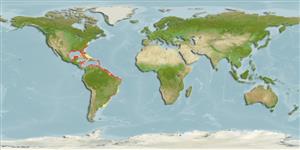Environment: milieu / climate zone / depth range / distribution range
Ecologia
marinhas; estuarina demersal; intervalo de profundidade ? - 55 m (Ref. 26912). Tropical; 20°C - 25°C (Ref. 36323)
Western Atlantic: southern Caribbean to Brazil. Record from the Virgin Islands needs verification.
Tamanho / Peso / Idade
Maturity: Lm ? range ? - ? cm
Max length : 26.0 cm TL macho/indeterminado; (Ref. 5217); common length : 20.0 cm TL macho/indeterminado; (Ref. 5217); peso máx. Publicado: 101.40 g (Ref. 118626)
Espinhos dorsais (total) : 10; Raios dorsais moles (total) : 12 - 14; Espinhos anais: 3; Raios anais moles: 7. Body dusky green with 2 longitudinal dark stripes; cheeks yellowish olive with diagonal blue stripes; fins dusky; anal and caudal fins with a tinge of yellow (Ref. 13608). Preopercle with a single prominent group of spines at the angle; 3 flat spines on posterior part of opercle. Soft portions of dorsal and anal fin bases without scales. Pectoral fin longer than pelvic fin. Caudal fin with no elongated ray (Ref. 36323).
Occurs commonly in coastal waters and also enter estuarine regions (Ref. 36323). Found over soft bottoms. Flesh is of good quality and is eaten fresh.
Life cycle and mating behavior
Maturities | Reprodução | Spawnings | Egg(s) | Fecundities | Larvas
Indeterminate fecundity with asynchronous ovarian organization (Ref. 115898).
Cervigón, F., R. Cipriani, W. Fischer, L. Garibaldi, M. Hendrickx, A.J. Lemus, R. Márquez, J.M. Poutiers, G. Robaina and B. Rodriguez, 1992. Fichas FAO de identificación de especies para los fines de la pesca. Guía de campo de las especies comerciales marinas y de aquas salobres de la costa septentrional de Sur América. FAO, Rome. 513 p. Preparado con el financiamento de la Comisión de Comunidades Europeas y de NORAD. (Ref. 5217)
Categoria na Lista Vermelha da IUCN (Ref. 130435)
Ameaça para o homem
Harmless
Utilização humana
Pescarias: pouco comercial
Ferramentas
Relatórios especiais
Descarregue XML
Fontes da internet
Estimates based on models
Preferred temperature (Ref.
123201): 22.7 - 27.9, mean 25.6 °C (based on 430 cells).
Phylogenetic diversity index (Ref.
82804): PD
50 = 0.5002 [Uniqueness, from 0.5 = low to 2.0 = high].
Bayesian length-weight: a=0.00631 (0.00449 - 0.00888), b=3.14 (3.04 - 3.24), in cm total length, based on LWR estimates for this species (Ref.
93245).
Nível Trófico (Ref.
69278): 4.1 ±0.68 se; based on food items.
Resiliência (Ref.
120179): Médio, tempo mínimo de duplicação da população 1,4 - 4,4 anos (Preliminary K or Fecundity.).
Fishing Vulnerability (Ref.
59153): Low vulnerability (16 of 100).
Nutrients (Ref.
124155): Calcium = 183 [78, 350] mg/100g; Iron = 0.97 [0.53, 1.79] mg/100g; Protein = 17.6 [15.8, 19.3] %; Omega3 = 0.188 [0.099, 0.368] g/100g; Selenium = 46.9 [23.7, 93.7] μg/100g; VitaminA = 30.5 [11.6, 96.1] μg/100g; Zinc = 1.39 [0.96, 1.98] mg/100g (wet weight);
